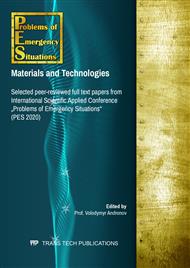[1]
V. V. Tiutiunyk, H. V. Ivanets, I. A. Tolkunov, E. I. Stetsyuk, System approach for readiness assessment units of civil defense to actions at emergency situations, Naukovyi Visnyk Natsionalnoho Hirnychoho Universytetu. 1 (2018) 99-105.
DOI: 10.29202/nvngu/2018-1/7
Google Scholar
[2]
A. Teslenko, A. Chernukha, O. Bezuglov, O. Bogatov, E. Kunitsa, V. Kalyna, A. Katunin, V. Kobzin, S. Minka. Construction of an algorithm for building regions of questionable decisions for devices containing gases in a linear multidimensional space of hazardous factors, Eastern-European Journal of Enterprise Technologies. 5/10 (101) (2019) 42 – 48.
DOI: 10.15587/1729-4061.2019.181668
Google Scholar
[3]
A. M. Levterov Thermodynamic properties of fatty acid esters in some biodiesel fuels, Functional Materials. 25/2 (2018) 308–312.
DOI: 10.15407/fm25.02.308
Google Scholar
[4]
M. V. Kustov, V. D. Kalugin, V. V. Tutunik, E. V. Tarakhno Physicochemical principles of the technology of modified pyrotechnic compositions to reduce the chemical pollution of the atmosphere, Voprosy Khimii i Khimicheskoi Tekhnologii. 1 (2019) 92–99.
DOI: 10.32434/0321-4095-2019-122-1-92-99
Google Scholar
[5]
S. Vambol, V. Vambol, Y. Suchikova, I. Bogdanov, O. Kondratenko Investigation of the porous GaP layers' chemical composition and the quality of the tests carried out, Journal of Achievements in Materials and Manufacturing Engineering. 86/2 (2018) 49–60.
DOI: 10.5604/01.3001.0011.8236
Google Scholar
[6]
O. Nekora, V. Slovynsky, S. Pozdieiev The research of bearing capacity of reinforced concrete beam with use combined experimental-computational method, MATEC Web of Conferences. 116 art. no. 02024 (2017).
DOI: 10.1051/matecconf/201711602024
Google Scholar
[7]
S. Pozdieiev, O. Nuianzin, S. Sidnei, S. Shchipets Computational study of bearing walls fire resistance tests efficiency using different combustion furnaces configurations, MATEC Web of Conferences. 116 art. no. 02027 (2017).
DOI: 10.1051/matecconf/201711602027
Google Scholar
[8]
V. Andronov, B. Pospelov, E. Rybka, Increase of accuracy of definition of temperature by sensors of fire alarms in real conditions of fire on objects, EasternEuropean Journal of Enterprise Technologies. 4/5 (82) (2016) 38–44.
DOI: 10.15587/1729-4061.2016.75063
Google Scholar
[9]
V. Andronov, B. Pospelov, E. Rybka, S. Skliarov, Examining the learning fire detectors under real conditions of application, EasternEuropean Journal of Enterprise Technologies, 3/9 (87) (2017) 53–59.
DOI: 10.15587/1729-4061.2017.101985
Google Scholar


